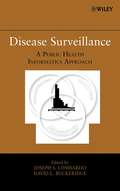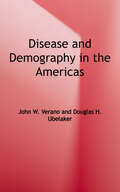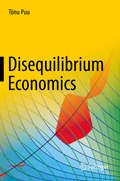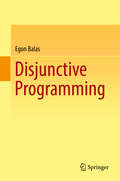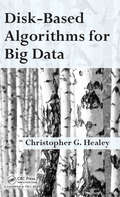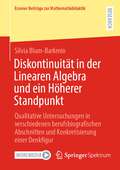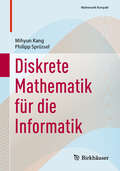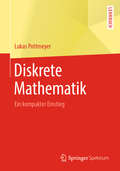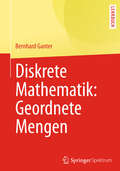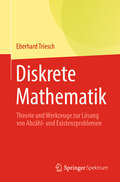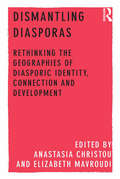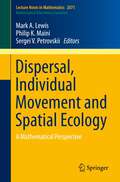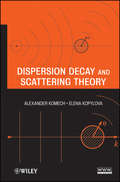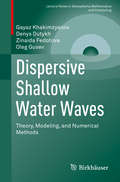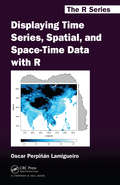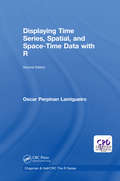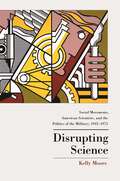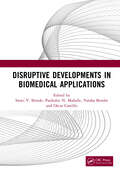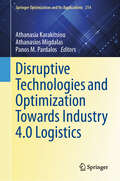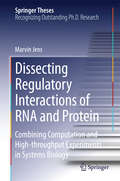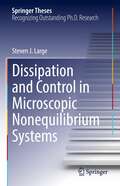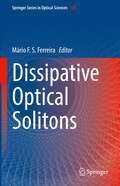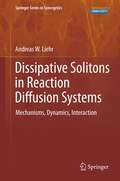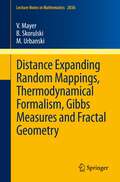- Table View
- List View
Disease Surveillance: A Public Health Informatics Approach
by Joseph S. Lombardo David L. BuckeridgeAn up-to-date and comprehensive treatment of biosurveillance techniques With the worldwide awareness of bioterrorism and drug-resistant infectious diseases, the need for surveillance systems to accurately detect emerging epidemicsis essential for maintaining global safety. Responding to these issues, Disease Surveillance brings together fifteen eminent researchers in the fields of medicine, epidemiology, biostatistics, and medical informatics to define the necessary elements of an effective disease surveillance program, including research, development, implementation, and operations. The surveillance systems and techniques presented in the text are designed to best utilize modern technology, manage emerging public health threats, and adapt to environmental changes. Following a historical overview detailing the need for disease surveillance systems, the text is divided into the following three parts: Part One sets forth the informatics knowledge needed to implement a disease surveillance system, including a discussion of data sources currently used in syndromic surveillance systems. Part Two provides case studies of modern disease surveillance systems, including cases that highlight implementation and operational difficulties as well as the successes experienced by health departments in the United States, Canada, Europe, and Asia. Part Three addresses practical issues concerning the evaluation of disease surveillance systems and the education of future informatics and disease surveillance practitioners. It also assesses how future technology will shape the field of disease surveillance. This book's multidisciplinary approach is ideal for public health professionals who need to understand all the facets within a disease surveillance program and implement the technology needed to support surveillance activities. An outline of the components needed for a successful disease surveillance system combined with extensive use of case studies makes this book well-suited as a textbook for public health informatics courses
Disease and Demography in the Americas
by John W. Verano Douglas H. UbelakerFeaturing 25 essays, this landmark book brings together the diverse views of leading international anthropologists and demographers on the patterns of populations and disease in the Americas both before and after 1492.
Disequilibrium Economics
by Tönu PuuThis book discusses mathematical models for various applications in economics, with a focus on non-linear dynamics. Based on the author’s over 50 years of active work in the field, the book has been inspired by models from the period between 1920 and 1950. Following a brief introduction to economics for mathematicians and other modelers, it assembles a repository of useful specific functions for global dynamic modeling. Furthermore, twelve “research stubs” – outlined research agendas that have not yet been fully worked on – are suggested for further study and could even be expanded to entire research projects. The book is a valuable resource, particularly for young scientists who are skilled in mathematical and computational techniques and are looking for applications in economics.
Disjunctive Programming
by Egon BalasDisjunctive Programming is a technique and a discipline initiated by the author in the early 1970's, which has become a central tool for solving nonconvex optimization problems like pure or mixed integer programs, through convexification (cutting plane) procedures combined with enumeration. It has played a major role in the revolution in the state of the art of Integer Programming that took place roughly during the period 1990-2010. The main benefit that the reader may acquire from reading this book is a deeper understanding of the theoretical underpinnings and of the applications potential of disjunctive programming, which range from more efficient problem formulation to enhanced modeling capability and improved solution methods for integer and combinatorial optimization. Egon Balas is University Professor and Lord Professor of Operations Research at Carnegie Mellon University's Tepper School of Business.
Disk-Based Algorithms for Big Data
by Christopher G. HealeyDisk-Based Algorithms for Big Data is a product of recent advances in the areas of big data, data analytics, and the underlying file systems and data management algorithms used to support the storage and analysis of massive data collections. The book discusses hard disks and their impact on data management, since Hard Disk Drives continue to be common in large data clusters. It also explores ways to store and retrieve data though primary and secondary indices. This includes a review of different in-memory sorting and searching algorithms that build a foundation for more sophisticated on-disk approaches like mergesort, B-trees, and extendible hashing. Following this introduction, the book transitions to more recent topics, including advanced storage technologies like solid-state drives and holographic storage; peer-to-peer (P2P) communication; large file systems and query languages like Hadoop/HDFS, Hive, Cassandra, and Presto; and NoSQL databases like Neo4j for graph structures and MongoDB for unstructured document data. Designed for senior undergraduate and graduate students, as well as professionals, this book is useful for anyone interested in understanding the foundations and advances in big data storage and management, and big data analytics. About the Author Dr. Christopher G. Healey is a tenured Professor in the Department of Computer Science and the Goodnight Distinguished Professor of Analytics in the Institute for Advanced Analytics, both at North Carolina State University in Raleigh, North Carolina. He has published over 50 articles in major journals and conferences in the areas of visualization, visual and data analytics, computer graphics, and artificial intelligence. He is a recipient of the National Science Foundation’s CAREER Early Faculty Development Award and the North Carolina State University Outstanding Instructor Award. He is a Senior Member of the Association for Computing Machinery (ACM) and the Institute of Electrical and Electronics Engineers (IEEE), and an Associate Editor of ACM Transaction on Applied Perception, the leading worldwide journal on the application of human perception to issues in computer science.
Diskontinuität in der Linearen Algebra und ein Höherer Standpunkt: Qualitative Untersuchungen in verschiedenen berufsbiografischen Abschnitten und Konkretisierung einer Denkfigur (Essener Beiträge zur Mathematikdidaktik)
by Silvia Blum-BarkminIn Schule und Hochschule sind unterschiedliche Sichtweisen auf Mathematik und speziell auf die Lineare Algebra festzustellen. Dieses Phänomen der Diskontinuität äußert sich in der Berücksichtigung des Realweltlichen, dem Umgang mit Anschauung, dem Grad der Abstraktion, der Art der Systematisierung und Ordnung der Konzepte und Phänomene sowie in der axiomatischen Grundlage mathematischer Betrachtungen. Silvia Blum-Barkmin charakterisiert Diskontinuität im Bereich der Linearen Algebra näher und untersucht empirisch den Umgang (angehender) Lehrkräfte mit Diskontinuität. Dazu nimmt sie eine vergleichende Analyse von Lehr-Lern-Materialien aus Schule und Hochschule zu den Begriffen Vektor und Skalarprodukt vor und arbeitet darin heraus, was Diskontinuität konkret bedeutet. Um den Umgang mit Diskontinuität zu erfassen, entwickelte sie ein stark inhaltsbezogenes interviewbasiertes Verfahren und wendete es in einer Studie mit Lehramtsstudierenden, Referendar*innen und Lehrkräften an. Sie entwickelt einen Vorschlag für eine Zielvorstellung für die universitäre Lehramtsausbildung für den Umgang von Lehrkräften mit Diskontinuität im Bereich der Linearen Algebra. Dieser greift eine bestehende normative Zielvorstellung für die fachliche Lehramtsausbildung, den Höheren Standpunkt, auf und verwendet den Kompetenzbegriff.
Diskrete Mathematik für die Informatik (Mathematik Kompakt)
by Mihyun Kang Philipp SprüsselDieses Buch richtet sich an Studierende in Studienrichtungen der Informatik zu Beginn ihres Studiums. Vorausgesetzt werden daher lediglich Kenntnisse der Schulmathematik. Behandelt werden grundlegende Themen aus dem Bereich der Diskreten Mathematik, mit besonderem Augenmerk auf Algorithmen und Anwendungen. Der Begriff "Diskrete Mathematik" ist hierbei weiter gefasst, als es in Deutschland zumeist üblich ist, und beinhaltet auch Teilbereiche der Zahlentheorie, Logik und erzeugender Funktionen. Selbstverständlich werden mit Abzählmethoden und Graphen auch klassische Themen der Diskreten Mathematik diskutiert. Zahlreiche Beispiele und Übungsaufgaben bieten eine optimale Vertiefung zum Verständnis der Materie an.
Diskrete Mathematik: Ein kompakter Einstieg
by Lukas PottmeyerDieses Lehrbuch gibt in kompakter Form und mit lockerem Stil einen ersten Überblick über zentrale Bereiche der diskreten Mathematik. Es ist zur Verwendung im ersten und zweiten Semester mathematischer Studiengänge geeignet: Sie benötigen als Leser kein tieferes mathematisches Vorwissen und werden behutsam an die mathematische Sprache herangeführt; alle behandelten Themen werden formal sauber und dennoch anschaulich und verständlich eingeführt. Auf ein eigenständiges Kapitel zur elementaren Logik und Beweisstrategien wird verzichtet, denn beides erlernen Sie beim Durcharbeiten implizit. Jedes Kapitel endet mit darauf abgestimmten Übungsaufgaben, deren Lösungen online bereitgestellt werden. Einige besonders zentrale und niedrigschwellige Übungsaufgaben sind explizit gekennzeichnet: Diese sollten Sie nach dem Studium des entsprechenden Kapitels lösen können, bevor Sie zum nächsten Kapitel weiterblättern.
Diskrete Mathematik: Geordnete Mengen
by Bernhard GanterDie Ordnungstheorie ist ein faszinierendes Teilgebiet der Diskreten Mathematik, das praktischen Nutzen und abstrakte mathematische Theorie, anschauliche Überlegungen und schwierige Forschungsprobleme auf manchmal verblüffende Art miteinander verbindet. Das Buch gibt eine motivierende Einführung in Grundbegriffe und moderne Strömungen der mathematischen Theorie geordneter Mengen, wobei der Autor sich auf besonders interessante Themen konzentriert. Da die Ordnungstheorie einfach und anspruchsvoll zugleich ist, abstrakt und angewandt, anschaulich und unvorstellbar, ist sie gerade für Studenten in der zweiten Hälfte des Bachelorstudiums und zu Beginn des Masterstudiums bestens geeignet.
Diskrete Mathematik: Theorie und Werkzeuge zur Lösung von Abzähl- und Existenzproblemen
by Eberhard TrieschDieses Lehrbuch führt auf prägnante und nachvollziehbare Art in die Abzähl- und Existenzprobleme der diskreten Mathematik ein. Es wendet sich an Studierende der Mathematik, der Informatik und benachbarter Gebiete und zeigt die Wirkmächtigkeit von einfachen Prinzipien. Dabei werden lediglich Grundkenntnisse in Linearer Algebra und Analysis, sowie elementare Wahrscheinlichkeitsrechnung vorausgesetzt. Thematisch spannt sich der Bogen von klassischen Ergebnissen der Kombinatorik über erzeugende Funktionen (mit einem Schwerpunkt im Bereich der Partitionen) bis hin zu probabilistischen Methoden in der Graphentheorie und der Konstruktion von Blockplänen und Codes. Somit führt das Buch bis hin zu Perlen des 21. Jahrhunderts und bietet sowohl Theorie als auch Werkzeuge für die Lösung von Problemen aus der diskreten Mathematik.
Dismantling Diasporas: Rethinking the Geographies of Diasporic Identity, Connection and Development
by Elizabeth Mavroudi Anastasia ChristouRe-energising debates on the conceptualisation of diasporas in migration scholarship and in geography, this work stresses the important role that geographers can play in interrupting assumptions about the spaces and processes of diaspora. The intricate, material and complex ways in which those in diaspora contest, construct and perform identity, politics, development and place is explored throughout this book. The authors ’dismantle’ diasporas in order to re-theorise the concept through empirically grounded, cutting-edge global research. This innovative volume will appeal to an international and interdisciplinary audience in ethnic, migration and diaspora studies as it tackles comparative, multi-sited and multi-method research through compelling case studies in a variety of contexts spanning the Global North and South. The research in this book is guided by four interconnected themes: the ways in which diasporas are constructed and performed through identity, the body, everyday practice and place; how those in diaspora become politicised and how this leads to unities and disunities in relation to 'here' and 'there'; the ways in which diasporas seek to connect and re-connect with their 'homelands' and the consequences of this in terms of identity formation, employment and theorising who 'counts' as a diaspora; and how those in diaspora engage with homeland development and the challenges this creates.
Dispersal, Individual Movement and Spatial Ecology
by Philip K. Maini Mark A. Lewis Sergei V. PetrovskiiDispersal of plants and animals is one of the most fascinating subjects in ecology. It has long been recognized as an important factor affecting ecosystem dynamics. Dispersal is apparently a phenomenon of biological origin; however, because of its complexity, it cannot be studied comprehensively by biological methods alone. Deeper insights into dispersal properties and implications require interdisciplinary approaches involving biologists, ecologists and mathematicians. The purpose of this book is to provide a forum for researches with different backgrounds and expertise and to ensure further advances in the study of dispersal and spatial ecology. This book is unique in its attempt to give an overview of dispersal studies across different spatial scales, such as the scale of individual movement, the population scale and the scale of communities and ecosystems. It is written by top-level experts in the field of dispersal modeling and covers a wide range of problems ranging from the identification of Levy walks in animal movement to the implications of dispersal on an evolutionary timescale.
Dispersion Decay and Scattering Theory
by Alexander Komech Elena KopylovaA simplified, yet rigorous treatment of scattering theory methods and their applicationsDispersion Decay and Scattering Theory provides thorough, easy-to-understand guidance on the application of scattering theory methods to modern problems in mathematics, quantum physics, and mathematical physics. Introducing spectral methods with applications to dispersion time-decay and scattering theory, this book presents, for the first time, the Agmon-Jensen-Kato spectral theory for the Schr?dinger equation, extending the theory to the Klein-Gordon equation. The dispersion decay plays a crucial role in the modern application to asymptotic stability of solitons of nonlinear Schr?dinger and Klein-Gordon equations.The authors clearly explain the fundamental concepts and formulas of the Schr?dinger operators, discuss the basic properties of the Schr?dinger equation, and offer in-depth coverage of Agmon-Jensen-Kato theory of the dispersion decay in the weighted Sobolev norms. The book also details the application of dispersion decay to scattering and spectral theories, the scattering cross section, and the weighted energy decay for 3D Klein-Gordon and wave equations. Complete streamlined proofs for key areas of the Agmon-Jensen-Kato approach, such as the high-energy decay of the resolvent and the limiting absorption principle are also included.Dispersion Decay and Scattering Theory is a suitable book for courses on scattering theory, partial differential equations, and functional analysis at the graduate level. The book also serves as an excellent resource for researchers, professionals, and academics in the fields of mathematics, mathematical physics, and quantum physics who would like to better understand scattering theory and partial differential equations and gain problem-solving skills in diverse areas, from high-energy physics to wave propagation and hydrodynamics.
Dispersive Partial Differential Equations: Wellposedness and Applications
by M. BURAK ERDO AN Nikolaos TzirakisThe area of nonlinear dispersive partial differential equations (PDEs) is a fast developing field which has become exceedingly technical in recent years. With this book, the authors provide a self-contained and accessible introduction for graduate or advanced undergraduate students in mathematics, engineering, and the physical sciences. Both classical and modern methods used in the field are described in detail, concentrating on the model cases that simplify the presentation without compromising the deep technical aspects of the theory, thus allowing students to learn the material in a short period of time. This book is appropriate both for self-study by students with a background in analysis, and for teaching a semester-long introductory graduate course in nonlinear dispersive PDEs. Copious exercises are included, and applications of the theory are also presented to connect dispersive PDEs with the more general areas of dynamical systems and mathematical physics.
Dispersive Shallow Water Waves: Theory, Modeling, and Numerical Methods (Lecture Notes in Geosystems Mathematics and Computing)
by Denys Dutykh Gayaz Khakimzyanov Zinaida Fedotova Oleg GusevThis monograph presents cutting-edge research on dispersive wave modelling, and the numerical methods used to simulate the propagation and generation of long surface water waves. Including both an overview of existing dispersive models, as well as recent breakthroughs, the authors maintain an ideal balance between theory and applications. From modelling tsunami waves to smaller scale coastal processes, this book will be an indispensable resource for those looking to be brought up-to-date in this active area of scientific research.Beginning with an introduction to various dispersive long wave models on the flat space, the authors establish a foundation on which readers can confidently approach more advanced mathematical models and numerical techniques. The first two chapters of the book cover modelling and numerical simulation over globally flat spaces, including adaptive moving grid methods along with the operator splitting approach, which was historically proposed at the Institute of Computational Technologies at Novosibirsk. Later chapters build on this to explore high-end mathematical modelling of the fluid flow over deformed and rotating spheres using the operator splitting approach. The appendices that follow further elaborate by providing valuable insight into long wave models based on the potential flow assumption, and modified intermediate weakly nonlinear weakly dispersive equations.Dispersive Shallow Water Waves will be a valuable resource for researchers studying theoretical or applied oceanography, nonlinear waves as well as those more broadly interested in free surface flow dynamics.
Displaying Time Series, Spatial, and Space-Time Data with R (Chapman And Hall/crc The R Ser.)
by Oscar Perpinan LamigueiroCode and Methods for Creating High-Quality Data GraphicsA data graphic is not only a static image, but it also tells a story about the data. It activates cognitive processes that are able to detect patterns and discover information not readily available with the raw data. This is particularly true for time series, spatial, and space-time datasets.F
Displaying Time Series, Spatial, and Space-Time Data with R: Displaying Time Series, Spatial, And Space-time Data With R (Chapman & Hall/CRC The R Series)
by Oscar Perpinan LamigueiroFocusing on the exploration of data with visual methods, this book presents methods and R code for producing high-quality static graphics, interactive visualizations, and animations of time series, spatial, and space-time data. Practical examples using real-world datasets help you understand how to apply the methods and code. Each of the three parts of the book is devoted to different types of data. In each part, the chapters are grouped according to the various visualization methods or data characteristics. Recent developments in the "htmlwidgets" family of packages are covered in this second edition with many new interactive graphics.
Disrupting Science: Social Movements, American Scientists, and the Politics of the Military, 1945-1975 (Princeton Studies in Cultural Sociology)
by Kelly MooreIn the decades following World War II, American scientists were celebrated for their contributions to social and technological progress. They were also widely criticized for their increasingly close ties to military and governmental power--not only by outside activists but from among the ranks of scientists themselves. Disrupting Science tells the story of how scientists formed new protest organizations that democratized science and made its pursuit more transparent. The book explores how scientists weakened their own authority even as they invented new forms of political action. Drawing extensively from archival sources and in-depth interviews, Kelly Moore examines the features of American science that made it an attractive target for protesters in the early cold war and Vietnam eras, including scientists' work in military research and activities perceived as environmentally harmful. She describes the intellectual traditions that protesters drew from--liberalism, moral individualism, and the New Left--and traces the rise and influence of scientist-led protest organizations such as Science for the People and the Union of Concerned Scientists. Moore shows how scientist protest activities disrupted basic assumptions about science and the ways scientific knowledge should be produced, and recast scientists' relationships to political and military institutions. Disrupting Science reveals how the scientific community cumulatively worked to unbind its own scientific authority and change how science and scientists are perceived. In doing so, the book redefines our understanding of social movements and the power of insider-led protest.
Disruptive Developments in Biomedical Applications
by Oscar Castillo Parikshit N. Mahalle Swati V. Shinde Varsha BendreThis book covers advancements and future challenges in biomedical application development using disruptive technologies like AI, IoT and signal processing. Book is divided into four main sections namely medical image processing using AI, IoT and biomedical devices, biomedical signal processing and electronic health records including advances in biomedical systems. It includes different case studies of biomedical applications using different AI algorithms related to diabetes, skin cancer, breast cancer, cervical cancer, osteoarthritis, and so forth. Features: Covers different technologies like AI, IOT and signal processing in the context of biomedical applications. Reviews medical image analysis, disease detection, and prediction. Comprehends the advantage of recent technologies for medical record keeping through electronics health records (EHRs). Presents state of art research in the field of biomedical engineering using various physiological signals. Explores different Bio Sensors used in Healthcare Applications using IOT. This book aims at Graduate students and researchers in artificial intelligence, medical imaging, biomedical engineering, and internet of things.
Disruptive Technologies and Optimization Towards Industry 4.0 Logistics (Springer Optimization and Its Applications #214)
by Panos M. Pardalos Athanasia Karakitsiou Athanasios MigdalasThis contributed volume guides researchers and practitioners on resource collaborative management of supply chains and manufacturing enterprises within an industrial internet technological environment. The book comprises 10 chapters that cover two major topics in the subject of logistics 4.0, namely the utilization of both disruptive technologies and optimization techniques in smart logistic management. With global research on the book's topic expanding rapidly across various directions and disciplines, it provides a structured framework for international experts to showcase outstanding work and unique approaches. Researchers and students will find the comprehensive outline on collaborative optimization and management of smart manufacturing and production, warehousing, inventory, logistics, transportation, integrated supply chain, and supply network within the industrial internet platform a beneficial guide to understanding current and future practical problems that arise in manufacturing and supply chain management.
Dissecting Regulatory Interactions of RNA and Protein
by Marvin JensThe work described in this book is an excellent example of interdisciplinary research in systems biology. It shows how concepts and approaches from the field of physics can be efficiently used to answer biological questions and reports on a novel methodology involving creative computer-based analyses of high-throughput biological data. Many of the findings described in the book, which are the result of collaborations between the author (a theoretical scientist) and experimental biologists and between different laboratories, have been published in high-quality peer-reviewed journals such as Molecular Cell and Nature. However, while those publications address different aspects of post-transcriptional gene regulation, this book provides readers with a complete, coherent and logical view of the research project as a whole. The introduction presents post-transcriptional gene regulation from a distinct angle, highlighting aspects of information theory and evolution and laying the groundwork for the questions addressed in the subsequent chapters, which concern the regulation of the transcriptome as the primary functional carrier of active genetic information.
Dissipation and Control in Microscopic Nonequilibrium Systems (Springer Theses)
by Steven J. LargeThis thesis establishes a multifaceted extension of the deterministic control framework that has been a workhorse of nonequilibrium statistical mechanics, to stochastic, discrete, and autonomous control mechanisms. This facilitates the application of ideas from stochastic thermodynamics to the understanding of molecular machines in nanotechnology and in living things. It also gives a scale on which to evaluate the nonequilibrium energetic efficiency of molecular machines, guidelines for designing effective synthetic machines, and a perspective on the engineering principles that govern efficient microscopic energy transduction far from equilibrium. The thesis also documents the author’s design, analysis, and interpretation of the first experimental demonstration of the utility of this generally applicable method for designing energetically-efficient control in biomolecules. Protocols designed using this framework systematically reduced dissipation, when compared to naive protocols, in DNA hairpins across a wide range of experimental unfolding speeds and between sequences with wildly different physical characteristics.
Dissipative Optical Solitons (Springer Series in Optical Sciences #238)
by Mário F. S. FerreiraThis book introduces the basic concept of a dissipative soliton, before going to explore recent theoretical and experimental results for various classes of dissipative optical solitons, high-energy dissipative solitons and their applications, and mode-locked fiber lasers.A soliton is a concept which describes various physical phenomena ranging from solitary waves forming on water to ultrashort optical pulses propagating in an optical fiber. While solitons are usually attributed to integrability, in recent years the notion of a soliton has been extended to various systems which are not necessarily integrable. Until now, the main emphasis has been given to well-known conservative soliton systems, but new avenues of inquiry were opened when physicists realized that solitary waves did indeed exist in a wide range of non-integrable and non-conservative systems leading to the concept of so-called dissipative optical solitons. Dissipative optical solitons have many unique properties which differ from those of their conservative counterparts. For example, except for very few cases, they form zero-parameter families and their properties are completely determined by the external parameters of the optical system. They can exist indefinitely in time, as long as these parameters stay constant. These features of dissipative solitons are highly desirable for several applications, such as in-line regeneration of optical data streams and generation of stable trains of laser pulses by mode-locked cavities.
Dissipative Solitons in Reaction Diffusion Systems
by Andreas W. LiehrWhy writing a book about a specialized task of the large topic of complex systems? And who will read it? The answer is simple: The fascination for a didactically valuable point of view, the elegance of a closed concept and the lack of a comprehensive disquisition. The fascinating part is that field equations can have localized solutions exhibiting the typical characteristics of particles. Regarding the field equations this book focuses on, the field phenomenon of localized solutions can be described in the context of a particle formalism, which leads to a set of ordinary differential equations covering the time evolution of the position and the velocity of each particle. Moreover, starting from these particle dynamics and making the transition to many body systems, one considers typical phenomena of many body systems as shock waves and phase transitions, which themselves can be described as field phenomena. Such transitions between different level of modelling are well known from conservative systems, where localized solutions of quantum field theory lead to the mechanisms of elementary particle interaction and from this to field equations describing the properties of matter. However, in dissipative systems such transitions have not been considered yet, which is adjusted by the presented book. The elegance of a closed concept starts with the observation of self-organized current filaments in a semiconductor gas discharge system. These filaments move on random paths and exhibit certain particle features like scattering or the formation of bound states. Neither the reasons for the propagation of the filaments nor the laws of the interaction between the filaments can be registered by direct observations. Therefore a model is established, which is phenomenological in the first instance due to the complexity of the experimental system. This model allows to understand the existence of localized structures, their mechanisms of movement, and their interaction, at least, on a qualitative level. But this model is also the starting point for developing a data analysis method that enables the detection of movement and interaction mechanisms of the investigated localized solutions. The topic is rounded of by applying the data analysis to real experimental data and comparing the experimental observations to the predictions of the model. A comprehensive publication covering the interesting topic of localized solutions in reaction diffusion systems in its width and its relation to the well known phenomena of spirals and patterns does not yet exist, and this is the third reason for writing this book. Although the book focuses on a specific experimental system the model equations are as simple as possible so that the discussed methods should be adaptable to a large class of systems showing particle-like structures. Therefore, this book should attract not only the experienced scientist, who is interested in self-organization phenomena, but also the student, who would like to understand the investigation of a complex system on the basis of a continuous description.
Distance Expanding Random Mappings, Thermodynamical Formalism, Gibbs Measures and Fractal Geometry
by Bartlomiej Skorulski Mariusz Urbanski Volker MayerThe theory of random dynamical systems originated from stochastic differential equations. It is intended to provide a framework and techniques to describe and analyze the evolution of dynamical systems when the input and output data are known only approximately, according to some probability distribution. The development of this field, in both the theory and applications, has gone in many directions. In this manuscript we introduce measurable expanding random dynamical systems, develop the thermodynamical formalism and establish, in particular, the exponential decay of correlations and analyticity of the expected pressure although the spectral gap property does not hold. This theory is then used to investigate fractal properties of conformal random systems. We prove a Bowen's formula and develop the multifractal formalism of the Gibbs states. Depending on the behavior of the Birkhoff sums of the pressure function we arrive at a natural classification of the systems into two classes: quasi-deterministic systems, which share many properties of deterministic ones; and essentially random systems, which are rather generic and never bi-Lipschitz equivalent to deterministic systems. We show that in the essentially random case the Hausdorff measure vanishes, which refutes a conjecture by Bogenschutz and Ochs. Lastly, we present applications of our results to various specific conformal random systems and positively answer a question posed by Bruck and Buger concerning the Hausdorff dimension of quadratic random Julia sets.
